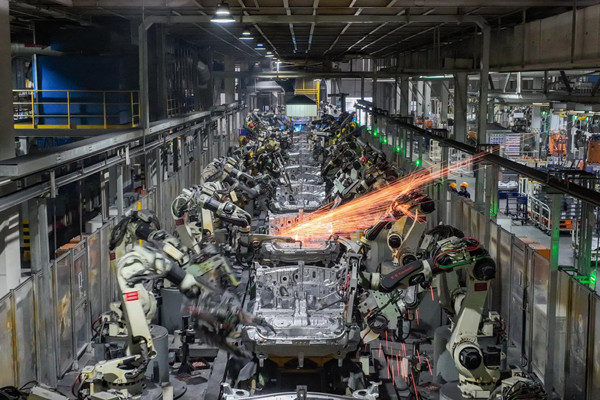Liangjiang poised to maintain embodied AI upper-hand

Robotic arms work on a production line in Changan Factory in Liangjiang New Area. [Photo by Wang Jiaxi]
In the tank area of a petrochemical plant, a special robot dodges obstacles and stands in front of a tank. In just 10 seconds, it completes a contactless scan of the tank and runs an automatic security analysis.
The robot is developed by Sevnce Robotics in Liangjiang New Area. Its body, made of titanium alloy, is not only extremely strong, but also explosion-proof and resistant to high temperatures and corrosion. Dog-shaped with four limbs, the robot is more flexible than tracked and wheeled robots.
It is just one example of how Chongqing is gaining a competitive edge in the embodied AI sector, with the city's manufacturing application scenarios and R&D breakthroughs on the rise, according to an official from the Chongqing Municipal Economy and Information Technology Commission.
Embodied intelligent robots, recognized as the next frontier of AI, refer to robots that perceive and interact with the surrounding environment. Able to plan, decide, and act autonomously, they are expected to play a crucial role in manufacturing, medical care, education, housekeeping, construction, and elderly care in the future.
As the center of the robotics industry in Chongqing, Liangjiang has been fostering a robotics industrial cluster since 2014, gathering more than 30 robotic companies and institutes.
The locally incubated Sevnce and German-based Agile Robots specialize in robot integration, the Chinese Academy of Sciences Chongqing Institute and THESEUS have made progress in sensors, and Bolaa has achieved 50 Petaflops in AI computing power.
At present, Chongqing is following a so-called "232 plan" to develop its robotics sector. This plan includes launching an initial set of two application scenarios — electronic terminals and new energy vehicles — developing three support systems for technological innovation, industry creation, and resource supply, and establishing two mechanisms: an industrial fund and a coordination framework.
According to the plan, Liangjiang will seek to attract funds, technology and talent investment, introduce key companies along the intelligent robot industrial chain, support the growth of current robot makers, and create a robotics industrial ecosystem.
Yang Hailan, deputy director of the Liangjiang New Area administrative committee, stated that the new area is striving to turn the intelligent equipment and manufacturing industry into one of its major industries, focusing on industrial robots, special robots, and service robots. The area will provide optimized, efficient services and create a first-class business environment for companies.



